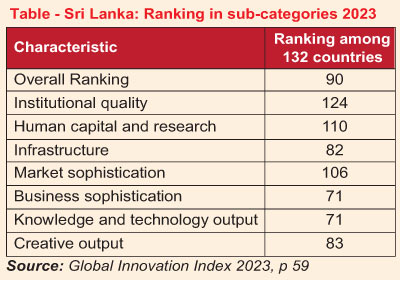Friday Nov 28, 2025
Friday Nov 28, 2025
Monday, 12 August 2024 00:45 - - {{hitsCtrl.values.hits}}

A nation desirous of surviving and prospering should necessarily embrace ‘innovation and creativity’
|
 There is a long list of Presidential hopefuls, but the voters will focus on five or six of them. From among them, one will be elected as the leader to steer the country to progress and prosperity. However, if they are to deliver prosperity to people, they should adopt policy strategies to accelerate economic growth at an unparalleled level of 8-9% annually over the next 25 years. This requires Sri Lanka to generate new inventions which should be commercially produced for the local as well as for global markets through innovations.
There is a long list of Presidential hopefuls, but the voters will focus on five or six of them. From among them, one will be elected as the leader to steer the country to progress and prosperity. However, if they are to deliver prosperity to people, they should adopt policy strategies to accelerate economic growth at an unparalleled level of 8-9% annually over the next 25 years. This requires Sri Lanka to generate new inventions which should be commercially produced for the local as well as for global markets through innovations.
Hence, inventions and innovations should receive the highest priority of those aspiring to win the forthcoming Presidential election in their policy strategies. This article series will provide the needed guidance to those Presidential hopefuls. It is an updated and a modified version of a previous paper written by the author for the Association of Professional Bankers.
Modern economies should be aptly termed innovation or creative economies
Modern economies are knowledge economies because they rely on knowledge for survival, growth, and sustenance. The period within which knowledge is said to have ruled the world spanned roughly for about five decades starting from the middle of the 20th century. During that period, the development of knowledge-creating activities, namely, education, training and learning received the highest priority in public policymaking. However, with the onset of the 21st century, the order of the world has substantially changed making knowledge a necessary but not a sufficient condition for continued prosperity of nations.
In the current context, knowledge still must lay the foundation for a nation to survive, sustain and prosper. It has now been recognised that with knowledge, there should be two other conditions that have to be put in place for knowledge to deliver its intended promise. They are ‘innovation and creativity’ which are used interchangeably to denote the same requirement. Hence, modern economies are called ‘innovation economies’ or interchangeably, ‘creative economies’.
 Need for using knowledge in practice has been emphasised all the time
Need for using knowledge in practice has been emphasised all the time
Thus, a nation desirous of surviving and prospering should necessarily embrace ‘innovation and creativity’ with fervour and reverence. Even in ancient times, it was recognised that knowledge without ability to apply in practice did not serve the person who has acquired knowledge or society he lives in. Chinese philosopher, Lao Tsu who lived in the 6th century BCE is said to have emphasised the importance of practice when he said that ‘knowledge is a treasure, but practice is the key to it’1. The 4th century BCE Indian Guru, Chanakya, also known as Kautilya, said in Chankya Neethi that ‘there is no use of knowledge confined to books only’ meaning that knowledge, for its proper benefit, must be applied in practice2.
Alison Wolf, London University’s Professor of Education, has argued in her 2002 book ‘Does Education Matter? Myths about education and economic growth’ that education matters only if it is relevant education and there are conditions conducive for the application of that education3. Hence, a mere knowledge building does not support a nation today. What would support a nation is the application of that knowledge in practice on a continuous basis. In recognition of this requirement, countries like South Korea have been trying to establish ‘creative economies’ and not mere knowledge economies in the 21st century4.
Knowledge that creates ‘inventions’ should be followed by ‘innovation’
It was the Austrian American economist Joseph Schumpeter who made the distinction between knowledge and application when he emphasised that inventions made by scientists and researchers should be followed by innovation by entrepreneurs. To complete the process, two other activities must be undertaken: diffusion of that knowledge of innovation in the economic system so that there would be massive imitation of same by others5.
He showed that inventions made by scientists, researchers or engineers are converted into usable goods and services by entrepreneurs by resorting to the process called innovation. Accordingly, without innovation, inventions just remain prototypes created by scientists with no benefit to society. Hence, modern economies should be properly termed ‘innovation economies’ or ‘creative economies’ and not mere ‘knowledge economies’.
Inventions do not help unless they are commercially used
Knowledge will enable researchers, engineers or scientists to create new things which are known as ‘inventions’. There are thousands of such inventions made by knowledgeable people every day. But not all these inventions lead to creating a commercially viable new product or service. For instance, there are stories of some Sri Lankan youth inventing remarkable new products such as a ‘seawater driven motor car’ or a ‘multi-tasked paddy-thresher’6. While such inventions have their own merit, they may not be commercially viable at the current stage of technology due to higher costs of production compared to available alternatives. Hence, they just remain as prototype inventions incapable of going through an assembly line of a factory that depends on commercial viability for its survival.
Joseph Schumpeter says that these inventions are used by entrepreneurs by converting them into commercial production lines7. That process is called ‘innovation’ or ‘doing things differently in the realm of economic life’. According to Schumpeter, innovation leading to continuous economic growth of a country is a process and it consists of 4 stages8.
Researchers lack capacity to use inventions commercially
The first stage is the invention where a researcher or a scientist, through elaborate experiments, comes up with a prototype of a new product. At the time of creating these inventions, the scientist or the researcher concerned has no idea about whether they would be commercially viable. He only knows that it would change the prevailing world habits or systems. Commercial viability comes from two other factors. One is that there should be a demand for the new product in preference to what is presently available in the market. The other is that the producers should be able to produce it at a cost that would generate him a profit when he sells it at prevailing market prices. If these two conditions are not met, the prototype invention will just remain an invention only on paper.
It is entrepreneurs that generate innovations
In the second stage known as innovation, enterprising people will draw, according to Schumpeter, on the discoveries of scientists or inventors and convert them to commercially viable products or services. By doing so, they create new opportunities for investment, growth and employment. But for them to do so, there should be mechanisms for making such new discoveries available to them for using in commercial production and guaranteeing their right to use them known in economics as ‘property rights’. This involves linking research institutions with business.
In the case of private research institutions, the question does not arise since private researchers should necessarily have to sell their research outputs to those who could use them productively. The problem arises with respect to state owned universities and research institutions which are normally reluctant to pass their research outputs to private sector owned businesses. They may be willing to share their knowledge with state owned businesses, but such businesses do not have proper business acumen to convert a research output into a viable market product.
Inventions need be taken forward by innovators
Hence, inventions per se do not lead to economic prosperity. There should be entrepreneurs who are willing and able to convert such inventions into marketable products. A good example is provided by Apple products. According to the biographer of Steve Jobs, Walter Isaacson, the first Apple Macintosh Desktop was invented by engineer Stephan Wozniak9. However, he was not an entrepreneur but a shy engineer. It was the enterprising Steve Jobs who carried the project forward and mobilised the resources needed for producing the Macintosh desktop computer on a commercial basis. So, if the innovator Steve Jobs were not there, the world would not have got the path-breaking Apple products that revolutionised the world’s information and communication technology applications.
Similarly, Corning Inc. had invented Gorilla Glass in 1960 for use by US Air Force in fighter jets but for some reason, Air Force had not used that invention. Then, in 2007, Gorilla Glass got a ready user when Apple’s iPhone needed a strong glass for the screen that was free from scratches10. If not for the innovator Steve Jobs, Gorilla Glass would have remained a mere invention forever. As Schumpeter had expected, the knowledge of Gorilla Glass got diffused instantly and all other smart phone manufacturers started imitating its use.
|
Innovations should get diffused
The third stage is called ‘diffusion’ or making available such knowledge to interested parties through the market mechanism. According to Schumpeter, it is the entrepreneurs who perform this task as well. Diffusion is a concept first put forward by Researcher Gabriel Tarde in 190311 when he said that knowledge disseminates over time taking the shape of a slanted English letter ‘S’. This is because every new product has its own ‘product life’ growing rapidly in the initial stage and then coming to a peak before it starts to decline again. At this stage, a new product will take the place of the old, discarded product.
Tarde identified 5 stages of the innovation process: Initial knowledge from the invention done by a researcher, forming an attitude on the invention, deciding whether to adopt or ignore the invention, using the invention in a commercial production and confirming the decision to adopt the invention continuously. Once one innovator comes to the market, there will be others who would follow his lead. It then leads to more inventions and innovations.
Successful innovations are imitated like a pandemic
The final stage arises from diffusion where other entrepreneurs would imitate the initial innovation. At this stage, innovation spreads across the economy like a pandemic. There will be hundreds and thousands of new entrepreneurs who would imitate the initial trailblazers. This was evident in the computer industry. Before 1970s, it was the mainframe computers that ruled the world. But after Stephan Wozniak and Steve Jobs broke the rules by producing the first Apple Macintosh desktop, a new desktop computer industry was developed throughout the globe. Then, it was a series of new inventions and innovations that started to supply the world with laptops, tablets, phablets and now hybrid tablets12.
Government’s role is to promote innovations
Thus, it is not knowledge per se that would usher prosperity to Sri Lanka. It is the conversion of knowledge into marketable goods and services through innovation, spread of the information on innovation through diffusion and imitation of such innovators that would bring a continuous high economic growth to a country. Hence, the role of the government is to create an environment conducive for invention, innovation, diffusion and imitation. This is where Sri Lanka lags many nations in the world as revealed by the latest Global Innovation Index or GII published by Cornell University, INSEAD and World Intellectual Property Organisation for 202313. The highest score which the best country can receive in the compilation is 100.
Sri Lanka is a laggard in the global innovation club
Considering some 80 different aspects relating to an innovation economy, GII has calculated an innovation score for 132 countries. Of them, Sri Lanka has scored 23.3 in 2023 down from 30.79 in 2015. Its global ranking is down from 85 in 2015 to 90 in 2023, a deterioration that cannot be ignored by the Presidential hopefuls. Historically, Sri Lanka has been a low-level innovation economy and the current GII has confirmed it. Hence, Sri Lanka’s current position is an eye-opener for the Government which is interested in establishing a ‘knowledge based competitive social market economy in the country’14.
|
Sri Lanka’s innovation efficiency is low
The index value is the combined outcome of two sub-indices, one on innovation inputs and the other on innovation outputs15. The ratio of outputs to inputs depicts the innovative efficiency of a country. If a country has an innovative efficiency ratio of more than or close to one, that country has a high innovative efficiency. Sri Lanka in this case has an efficiency ratio of 0.7716 needing much improvement on the innovation front. The innovation inputs consist of five broad categories, namely, institutional structure, human capital and research, infrastructure, market sophistication and business sophistication. In innovation outputs, there are two categories, namely, knowledge and technology and creativity. In all these categories, Sri Lanka’s performance as an innovative economy has been far from the desired. It also opens a wide policy corridor for Sri Lanka Government to adopt for implementation if it is really interested in building its knowledge base and its application in business.
To be continued.
Footnotes:
1See: https://www.goodreads.com/author/quotes/2622245.Lao_Tzu?page=2
2Ethics of Chanakya, (Translator: Tantrik Yogi Ramesh) Sahini Publications, 1998, p 101
3Alison Wolf (2002) Does Education Matter? Myths about education and economic growth, Penguin Books.
4See:
http://english.motie.go.kr/wp-content/uploads/2014/10/Koean-Industrial-Initiative-for-the-Creative-Economy.pdf and visit: https://ccei.creativekorea.or.kr/main.do
5https://www.academia.edu/5396861/SCHUMPETER_S_VIEW_ON_INNOVATION_AND_ENTREPRENEURSHIP
6Media regularly report on such cases highlighting that such inventions should be converted to commercial production by the government.
7Schumpeter, (1934) The Theory of Economic Development, (Translated by Redvers Opie)
8This section draws heavily on: https://www.academia.edu/5396861/SCHUMPETER_S_VIEW_ON_INNOVATION_AND_ENTREPRENEURSHIP
9Walter Isaacson, (2011), Steve Jobs, Simon and Schuster. New York.
10Vogelstein, Fred, (2013), Dogfight: How Apple and Google went to war and started a revolution, William Collins, London, p 37
11Katz, E. (2006). Rediscovering Gabriel Tarde. Political Communication, 23 (3), 263-270. http://dx.doi.org/10.1080/
10584600600808711
12For details of the on-going battle for supremacy in ICT, visit: http://www.gizmag.com/
13Available at: https://www.wipo.int/edocs/pubdocs/en/wipo-pub-2000-2023-en-main-report-global-innovation-index-2023-16th-edition.pdf
14For a detailed analysis of this economic ideology, see Wijewardena (2015) at http://www.ft.lk/article/469707/Part-I-%E2%80%93-The-promise-of-a-Knowledge-based-Competitive-Social-Market-Economy--What-does-it-herald-for-Sri-Lanka
15The Global Innovation Index 2023, p 57.
16Ibid p 192.
(The writer, a former Deputy Governor of the Central Bank of Sri Lanka, can be reached at [email protected].)